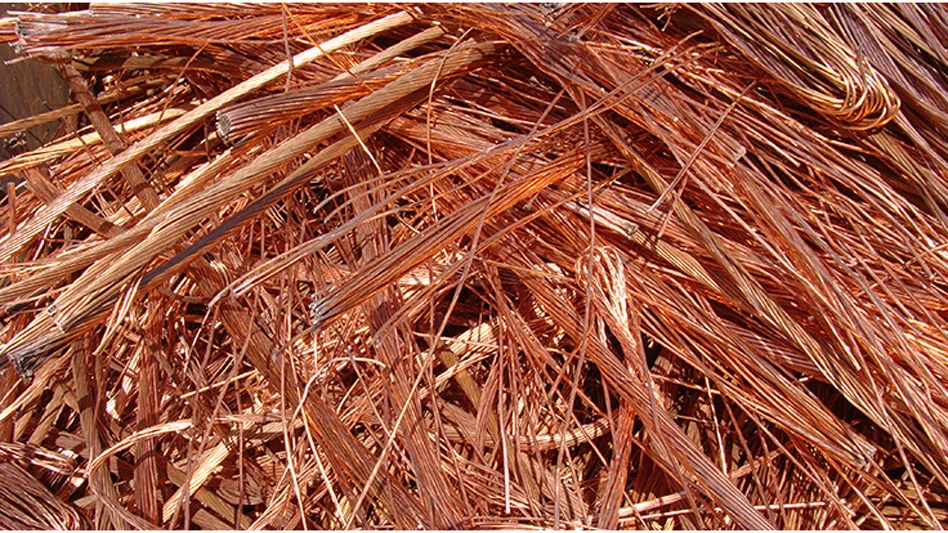
Recycling Today file photo
Mid-November brought good news in the form of a constructive meeting between U.S. President Joe Biden and Chinese President Xi Jinping, an avoided government shutdown and cooling inflation as well as falling interest rates and the value of the dollar relative to other currencies, John E. Gross of "The Copper Journal" notes as of Nov. 17, with the latter primarily benefitting copper and precious metals.
COMEX copper futures settled at $3.74 per pound at the end of trading Nov. 17, while three-month copper on the London Metal Exchange (LME) also rose in value. In addition to the softer dollar, Reuters reports that LME copper prices rose to their highest in nearly eight weeks Nov. 20 fueled by hopes of improving demand after Chinese officials promised support for that country’s property sector.
Despite the rising hopes, the current market is something of a mixed bag for copper scrap processors in North America.
Patrick Merrick, president of W. Silver Recycling Inc., which is based in El Paso, Texas, with operations in Texas and Mexico, says industrial scrap generation remains strong, which he attributes to the growth of manufacturing in the region in response to nearshoring efforts. “I do think Mexico is seeing more growth than in the rest of North America,” he says.
W. Silver has a diverse supply base, Merrick says, that includes automotive and consumer goods producers.
He predicts growth in industrial scrap generation will stabilize in 2024.
However, a scrap processor based in the Northeast U.S. describes scrap generation in his region as being very low. “The trade is fighting for the little supply out there,” he says, citing the weak economy is “by Fed design to cool inflation.”
He says weak generation has been met by weak demand. “Customers are ordering only as needed and maintaining very low inventories due to weak order books and high cost of carrying inventory," he adds. "When customers are ordering, typically they are providing very little lead time, so we need to be ready when customers call.”
Merrick says he’s found copper scrap demand to be more consistent than aluminum demand, which he describes as “choppy.” He believes aluminum has a better balance between supply and demand, while “copper scrap still is in a deficit.”
Merrick also says the gap between pricing for secondary and primary aluminum scrap grades has condensed as 2023 has progressed. “There’s less importance of segregating alloys than there was before. Premiums are not quite as attractive as they were before.”
Export demand for red metals also remains healthy, with China being a primary destination, Merrick says, adding that the country is paying healthy premiums, as well.
The processor based in the Northeast says export demand is having a significant positive effect on the U.S. market. “Export creates a competitive environment,” he says, adding that “spreads would most certainly be wider” without this demand.
Merrick predicts copper scrap spreads relative to the LME and COMEX will continue to tighten as a result of export demand.
For the first nine months of the year, China remains the dominant export buyer of U.S. recycled copper, with shipments to mainland China up 4.4 percent year to date to nearly 227,000 metric tons, according to U.S Census Bureau and U.S. International Trade Commission data cited by the Institute of Scrap Recycling Industries in the “Weekly Market Report” e-newsletter dated Nov. 17. However, U.S. exports of recycled copper and copper alloys overall declined by 9.2 percent in volume terms year over year through September to less than 642,000 metric tons and by 12 percent in dollar terms to $3.35 billion.
Latest from Recycling Today
- BMW Group, Encory launch 'direct recycling’ of batteries
- Loom Carbon, RTI International partner to scale textile recycling technology
- Goodwill Industries of West Michigan, American Glass Mosaics partner to divert glass from landfill
- CARI forms federal advocacy partnership
- Monthly packaging papers shipments down in November
- STEEL Act aims to enhance trade enforcement to prevent dumping of steel in the US
- San Francisco schools introduce compostable lunch trays
- Aduro graduates from Shell GameChanger program





